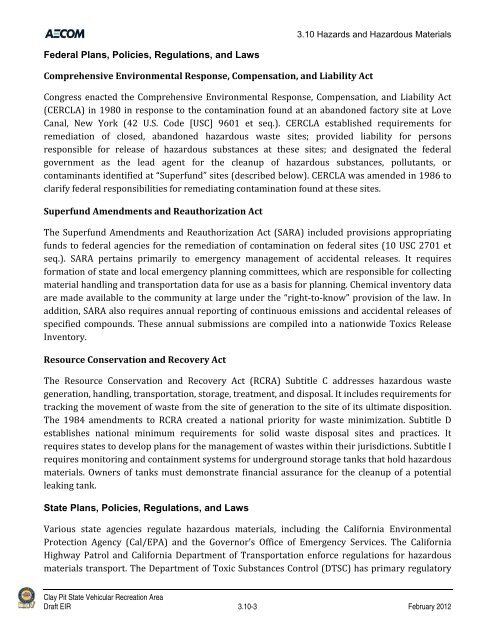Draft Environmental Impact Report - California Off Highway Vehicle ...
Draft Environmental Impact Report - California Off Highway Vehicle ...
Draft Environmental Impact Report - California Off Highway Vehicle ...
Create successful ePaper yourself
Turn your PDF publications into a flip-book with our unique Google optimized e-Paper software.
Federal Plans, Policies, Regulations, and Laws<br />
Comprehensive <strong>Environmental</strong> Response, Compensation, and Liability Act<br />
3.10 Hazards and Hazardous Materials<br />
Congress enacted the Comprehensive <strong>Environmental</strong> Response, Compensation, and Liability Act<br />
(CERCLA) in 1980 in response to the contamination found at an abandoned factory site at Love<br />
Canal, New York (42 U.S. Code [USC] 9601 et seq.). CERCLA established requirements for<br />
remediation of closed, abandoned hazardous waste sites; provided liability for persons<br />
responsible for release of hazardous substances at these sites; and designated the federal<br />
government as the lead agent for the cleanup of hazardous substances, pollutants, or<br />
contaminants identified at “Superfund” sites (described below). CERCLA was amended in 1986 to<br />
clarify federal responsibilities for remediating contamination found at these sites.<br />
Superfund Amendments and Reauthorization Act<br />
The Superfund Amendments and Reauthorization Act (SARA) included provisions appropriating<br />
funds to federal agencies for the remediation of contamination on federal sites (10 USC 2701 et<br />
seq.). SARA pertains primarily to emergency management of accidental releases. It requires<br />
formation of state and local emergency planning committees, which are responsible for collecting<br />
material handling and transportation data for use as a basis for planning. Chemical inventory data<br />
are made available to the community at large under the “right‐to‐know” provision of the law. In<br />
addition, SARA also requires annual reporting of continuous emissions and accidental releases of<br />
specified compounds. These annual submissions are compiled into a nationwide Toxics Release<br />
Inventory.<br />
Resource Conservation and Recovery Act<br />
The Resource Conservation and Recovery Act (RCRA) Subtitle C addresses hazardous waste<br />
generation, handling, transportation, storage, treatment, and disposal. It includes requirements for<br />
tracking the movement of waste from the site of generation to the site of its ultimate disposition.<br />
The 1984 amendments to RCRA created a national priority for waste minimization. Subtitle D<br />
establishes national minimum requirements for solid waste disposal sites and practices. It<br />
requires states to develop plans for the management of wastes within their jurisdictions. Subtitle I<br />
requires monitoring and containment systems for underground storage tanks that hold hazardous<br />
materials. Owners of tanks must demonstrate financial assurance for the cleanup of a potential<br />
leaking tank.<br />
State Plans, Policies, Regulations, and Laws<br />
Various state agencies regulate hazardous materials, including the <strong>California</strong> <strong>Environmental</strong><br />
Protection Agency (Cal/EPA) and the Governor’s <strong>Off</strong>ice of Emergency Services. The <strong>California</strong><br />
<strong>Highway</strong> Patrol and <strong>California</strong> Department of Transportation enforce regulations for hazardous<br />
materials transport. The Department of Toxic Substances Control (DTSC) has primary regulatory<br />
Clay Pit State Vehicular Recreation Area<br />
<strong>Draft</strong> EIR 3.10-3 February 2012








